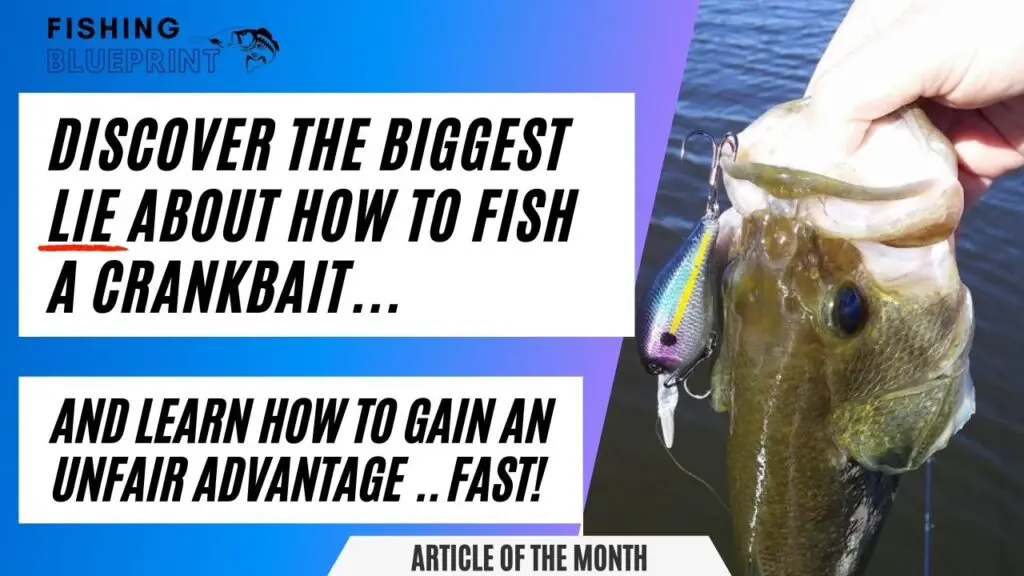Lake Havasu Fishing Tips | Your Lake Havasu Fishing Report
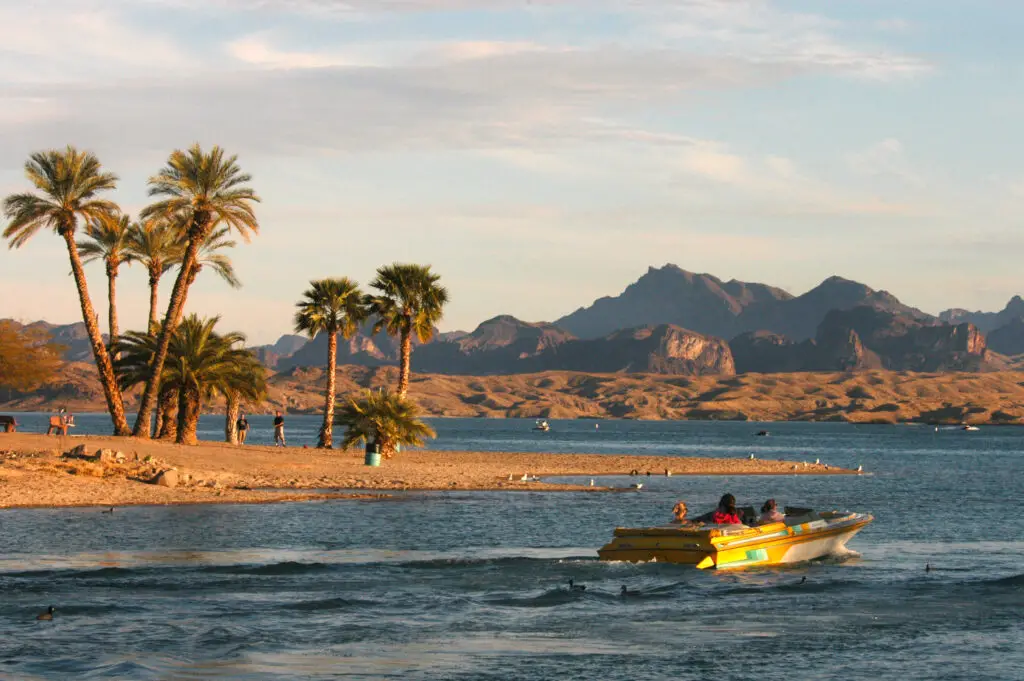
photo – azgfd
Lake Havasu is a large semi-deep reservoir lake that sits just 193 miles away from Arizona’s largest city Phoenix.
Lake Havasu used to only be known as a college spring break party lake. However, Lake Havasu Fisheries Improvement Program (LHFIP) has worked with the Bureau of Land Management (BLM) to develop 875 acres of artificial fish habitat and five free fishing piers open to the public in and around Lake Havasu beginning in 1992.
Since then, the quality of fishing has exploded. Lake Havasu has been voted consistently within the 100 Fishing Lakes in the United States and provides locals and visitors the opportunity to test their luck in catching one of the many game species this lake has to offer, such as Striped Bass, Largemouth Bass, Smallmouth Bass, Channel Catfish, Bluegill, and much, much more!
So what are the best tips for fishing Lake Havasu? There are three important factors you must know if you want to know how to fish Lake Havasu successfully. First, you need to know what kind of fish is in the lake. Second, it’s important for you to know which part of the lake each species can be found in. Lastly, what are the best baits that work on Lake Havasu? Remember, tactics, baits, and locations will be different for each type of fish. So let’s talk about the steps you need to take in order to give you the best chance of catching a fish on Lake Havasu.
Key Takeaways
This lake gives locals and visitors the opportunity to test their luck in catching one of the many game species this lake has to offer, such as White Bass, Smallmouth Bass, Striped Bass, Largemouth Bass, Channel Catfish, Bluegill, and much, much more!
Here’s the most recent and updated Lake Havasu Fishing Report – it gives you a quick and easy list of some really good fishing spots you’ll definitively want to check out! If you’re looking for more detail on how to fish each spot scroll down into the article.
- Upper River: Catfish Bay, Jops Harbor, Castle Rock Bay, Blankenship Bend
- Mid Lake: Windsor Beach Area, Chalk Cliffs to Ski Cove Three, Ski Cove One to Grass Island, Daytona Wash to Contact Point, Three Points to Teal Point, Havasu Palms into Whipple Bay
- Lower Lake: Three Dunes Point to Cattail Cove State Park, Bass Isles to Powerline Cove, Bill Williams River.
Here are some additional fast and helpful tips just for you:
- The easiest way to fish this lake is by boat, but there are areas to fish from the bank, by kayak, or float tube.
- You can access the lake from the California side or the Arizona side.
- There are multiple public boat ramps to use.
- Camping and RV parking is available.
- You can buy tackle and groceries at the lake or at one of the tackle shops in Phoenix.
- A permit is required to enter, camp, and fish this lake. Prices vary depending on your desired activity.
About Lake Havasu
Collectively, Lake Havasu is a very popular lake for both anglers and college spring break party-goers. Lake Havasu is located on the western edge of the state and sits between Arizona and California. In this post, you’re going to be given the blueprint to fish this lake.
Lake Havasu is a semi-deep body of water with the average depth being 35 feet and a maximum depth of 90 feet when the lake is completely full. It’s a long lake spanning over 26 miles long and 2.85 miles across, the lake is spread over 19,300 acres when completely full. This reservoir helps distribute water to all the southwest Arizona and California agriculture farms.
Lake Havasu is also home to the London Bridge. The London Bridge was disassembled in London, England, and each stone was numbered for re-assembly at Lake Havasu City. The bridge was delivered to the Port of Long Beach, California, and then moved overland to Lake Havasu City, where it was reassembled in 1968.
What Kinds of Fish Are In Lake Havasu
- Striped Bass
- Largemouth Bass
- Smallmouth Bass
- Bluegill
- Black Crappie
- Channel Catfish
- Flathead Catfish
- Bluegill
- Green Sunfish
- Red Ear Sunfish
- Tilapia
- Carp
My personal fishing report update:
Alright, my fishing friends, let’s dive into the current scene on the water.
Lately, the wind’s been tossing us a curveball, making our quest for that trophy a bit more of an adventure.
But, as any savvy angler knows, those breezy conditions can’t keep a good fisherman down. In fact, some folks are absolutely slaying it with largemouth and striped bass during those calm windows between weather fronts.
So, here’s the lowdown: those northern coves are still where the party’s at, although our bass buddies are doing a bit of a dance—moving in and out depending on whether they’re cozying up on their beds.
Some anglers have been hitting the shallows, about 4 feet deep, with a trusty drop shot setup and have been hooking into some beauties. Then, shifting gears and going deeper, they bagged a chunky 6-pounder. Tallying up, they netted themselves 15 to 20 largemouths, most tipping the scales between 1 and 2.5 pounds.
And get this, the bass are in full-on love mode in the shallows at the back of the coves, while the post-spawn crowd is hanging out off the points, islands, and reefs. The numbers might not be blockbuster yet, but patience is key.
Helpful tip: anything white will be like bass candy right now— jerkbaits, crankbaits, you name it.
For the lure lovers here’s a list of what is working right now:
- Topwaters
- Swimbaits
- Umbrella rigs
- Jerkbaits
- Football jigs
- Crankbaits
- Drop shot
- Texas rig worm or creature baits
- Carolina rig
Guys, the northern hideouts where the bass are busy spawning and can be easily caught.
I got talking to a guy loading his kayak who fished from mid-morning to afternoon and landed two largemouths on drop shots.
So there you have it, my angling amigos…
The fish are out there, dancing with the elements, and it’s up to us to join the party. Keep those lines tight and your spirits high, and remember, every day on the water is a good day.
Lake Havasu Fishing Tips
Water Clarity
First things first, let’s talk about water clarity. Lake Havasu has some of the clearest water you’ll ever see. It’s so clear that you can sight fish for largemouth and smallmouth bass, which is always a thrill. But here’s the thing, that clear water can make catching bigger fish a challenge. You’ll often find that lighter lines and smaller lures will get more bites here.
Water Temperature
Now, let’s talk water temperature.
- In the spring (February, March, April), the water temperature in Lake Havasu can range from the low 60s to the high 70s. This is when largemouth bass move onto the beds and provide some fantastic action.
- In the summer (May, June, July, August), the water temperature can reach into the mid to high 80s, which means the bass will move deeper to cooler water.
- In the fall (October, November), the water temperature starts to cool down again, which means the bass will start moving into shallower waters.
- In the winter (December, January), the water temperature can get down to the low 50s, which means the bass will be even deeper.
Structures and Fishing Cover
Now, let’s talk structures and fishing cover. Lake Havasu has a lot of man-made structures that provide excellent cover for bass. These structures include:
- Artificial reefs
- Drop-offs
- Sheer canyon walls
- Rock piles
- Coves
- Docks
- Points
- Creek channels
You’ll want to focus on these structures if you want to catch some big bass. In addition to these structures, there’s also plenty of natural cover like weed beds, reeds, and fallen trees.
Later on in this report, I’m going to share with you some great spots you can catch some fish.
Expected Water Temperature for Bass Spawn
As you may know, water temperature plays a huge role in bass spawning behavior. Here’s what you need to know about Lake Havasu:
- The expected water temperature for largemouth and smallmouth bass to start spawning on Lake Havasu is around 60-65°F (15.5-18.3°C).
- Striped bass, on the other hand, prefer slightly cooler water temperatures for spawning, typically around 55-60°F (12.7-15.5°C).
- Crappie also spawn in the spring when the water temperature is around 60°F (15.5°C), but they tend to prefer shallower areas with vegetation cover.
Time of Year and Specific Locations for Bass Spawn
Now that we know the ideal water temperature for bass spawn, let’s take a look at the best times and locations for each species:
- Largemouth bass typically spawn in late February through May, with the peak of the spawn occurring in April. They tend to spawn in shallow areas with plenty of vegetation cover such as reeds, tules, and flooded brush. Look for these structures in the northern end of the lake, especially in the vicinity of the Bill Williams River arm and Topock Marsh.
- Smallmouth bass usually spawn later than largemouth, from mid-March to early May, with the peak in April. They tend to prefer rocky structures and boulder-lined banks, especially in the deeper parts of the lake. Good areas to target include the Castle Rock and Copper Canyon areas, as well as the eastern and western sides of the lake near the Parker Dam.
- Striped bass spawn from late February to early May, with the peak in late March to early April. They prefer deeper water, typically in the main channel and around the Colorado River inlets. Look for them around the Parker Dam and the intake structures of the Central Arizona Project (CAP) canal.
- Crappie spawn from late February to early April, with the peak in March. They prefer shallow areas with submerged vegetation, especially in the northern end of the lake near the Bill Williams River arm and the Topock Marsh.
Here are some things to keep in mind for spring bass fishing:
- Air Temperature: In the spring, temperatures on Lake Havasu can range from the low 60s to the high 80s. Keep an eye on the forecast and plan accordingly. Remember, the colder the water, the slower the bass will be.
- Wind Speed and Direction: Wind is always a factor when fishing, and Lake Havasu can be particularly windy in the spring. Pay attention to the wind direction, as it can impact the location of baitfish and ultimately where the bass are feeding.
- Storms and Rain: Spring in Arizona can bring sudden storms and rain showers. Be sure to check the forecast before heading out and have a plan in place for seeking shelter if necessary.
- Water Level: During the spring, Lake Havasu’s water level can fluctuate due to increased rainfall and snowmelt from the surrounding mountains. Keep an eye on the water level and adjust your fishing tactics accordingly.
Post Spawn Behavior
Alright, let’s talk about what happens to bass and crappie after they’ve finished spawning on Lake Havasu!
- After spawning, bass and crappie typically move to deeper water to recover and feed.
- Specifically, they will often move to offshore natural and artificial structure, such as points, ledges, and drop-offs.
- Look for areas with plenty of cover and structure, such as submerged trees and brush piles, as these will attract baitfish and provide a feeding ground for post-spawn bass and crappie.
- During the summer months, these fish may also be found near submerged vegetation and weed lines.
- As fall approaches and water temperatures begin to cool, look for bass and crappie to start moving back toward shallower water in preparation for the winter months.
On Lake Havasu specifically, some areas to target for post-spawn bass and crappie include:
- Points and drop-offs around the island and coves on the lake’s south side.
- The submerged trees and brush piles around the Colorado River inlet and the Bill Williams River arm of the lake.
- Offshore structure and weed lines in the north end of the lake, near Castle Rock and Steamboat Cove.
What do bass eat during the summer on Lake Havasu?
During the summer months, bass on Lake Havasu are typically feeding on a variety of baitfish, including shad and bluegill. Some of the most common prey items for summer bass on Lake Havasu include:
- Shad
- Bluegill
- Crawfish
- Frogs
Here are common baits to catch bass in the summer on Lake Havasu
If you’re looking to hook into some bass during the summer on Lake Havasu, here are five baits that are definitely worth trying:
- Senko Worms: These soft plastic stick baits are a tried-and-true favorite for many bass anglers. Try fishing them weightless or wacky-rigged in shallow water around cover.
- Crankbaits: During the summer, crankbaits can be a great way to cover water and locate active fish. Try fishing them along rocky points and drop-offs.
- Spinnerbaits or Chatterbaits: Spinnerbaits and Chatterbaits are another great bait for covering water and triggering reaction strikes from hungry bass. Try fishing them around shallow cover or along weedlines.
- Jigs: Jigs are a versatile bait that can be fished in a variety of ways, from dragging them along the bottom to swimming them through cover. Try fishing them around rocky areas or along deep drop-offs.
- Swimbaits: Swimbaits can be a great way to target larger bass during the summer months. Try fishing them around schools of shad or other baitfish.
- Topwater frogs: These little baits mimic small frogs commonly found around vegetation mats, reed beds, and tullie thickets that line the pockets coves.
Where to go during the summer?
Here are three specific areas on Lake Havasu where you might find some summer bass:
- The Tire Reef: Located near Site Six, the Tire Reef is a popular spot for summer bass fishing. Try fishing crankbaits or jigs along the rocky bottom.
- The Sandbar: The Sandbar is a shallow area near the London Bridge that is home to a lot of baitfish during the summer months. Try fishing topwater baits or swimbaits in this area.
- Cattail Cove: Cattail Cove is a shallow area on the northern end of the lake that is known for its weedbeds. Try fishing topwater baits or weedless soft plastics in this area.
Striper fishing
Fishing for stripers is incredibly fun. Sometimes they can be finicky to catch. Here are tips to catch stripers at this lake:
- Most of the time you will find striped bass shallow chasing shad in the spring, then deeper waters between 50 to 90 feet deep in the summer.
- Striped bass can be caught on this Lake using spoons, poppers, topwater walking baits in the morning when they are chasing shad near the surface of the water. As the day continues, the striped bass will dive to deeper water and will continue to feed.
- Trolling live and artificial baits will give you your best chances of catching a deep striped bass.
Common summer weather patterns for Lake Havasu
Summer weather on Lake Havasu can be hot and dry, with average temperatures ranging from the mid-80s to the low-100s. Wind speeds can vary, but it’s not uncommon to experience occasional gusts of up to 20 or 30 miles per hour. Here are some more specific weather patterns to look out for during the summer months:
- May: May can be a great time for topwater fishing on Lake Havasu, particularly in the early morning or late evening. Look for overcast days or periods of cloud cover to help keep fish active throughout the day.
- June: In June, the water temperature on Lake Havasu can start to really heat up. Look for deeper water and areas with good current flow to find active fish.
- July: By July, the heat can really start to take its toll on both fish and anglers. Try fishing early in the morning or late in the evening to avoid the hottest parts of the day.
- August: As summer starts to wind down, fish can become more active again as temperatures start to cool off. Look for schools of shad or other baitfish to locate active fish.
But Where Are The Best Places To Fish At Lake Havasu?
In this list, I’m going to show you the best fishing spots at Lake Havasu. However, it will be broken up into sections: Upper River, Mid Lake, Lower Lake.
DISCLAIMER: The material provided is for general information purposes only. It’s important to understand that any information provided in this article can change at any time. Any maps or graphics featured are not to be used as navigational aids. Fishing Blueprint will not be responsible for any personal injury or property damage from any misuse of the maps or graphics provided. It’s completely impossible to give you every single spot where you can potentially catch a fish. But, what this list does do is to give you a helping hand and narrow down to the most productive fishing spots.
Special Closures Areas or Restrictions:
Fire Restrictions. Wildfires can occur around Lake Havasu. Sometimes there will be no-entry areas restricting access to non-government boaters.
Private Property Restrictions. Before fishing around any marinas please make sure you are not entering a private area. Furthermore, if an owner has a “no fishing” around their dock or boat please respect their request. Lake Havasu has plenty of other locations to fish.
Upper River
Catfish Bay

Fishing just north of where the Colorado river drains into the main lake, Catfish Bay is a sheltered bay characterized by reeds and tulles to the north side and shallow rocky points to the south.
This is a great spot if you encounter Havasu’s strong winds or strong currents.
Largemouth can be found in and around the tulles and smallmouth can be caught around rocky points and cuts.
Here’s a list of effective baits and techniques you can use in this area:
Calm or post-frontal conditions: Senkos, drop shot rig, tubes, Neko rig, football jigs
Windy, pre-frontal, summer conditions: spinnerbaits, crankbaits, swim jigs, chatterbaits, and underspin jigs.
Artificial habitat/structure: drop shot rig, crankbaits, Neko rig, wacky worm
Grass/ reeds/ tulles: If the grass is submerged you fish over the tops with a topwater lure, buzzbaits, frog lure, chatterbaits, or whopper plopper.
Fish the weedline edges parallel with crankbaits, lipless crankbaits, spinnerbaits, frog lures, soft plastic swimbaits, umbrella rigs, swim jigs, underspin jigs, or chatterbaits.
Rocks, points, cuts: crankbaits, jigs, Texas rigs, and Carolina rigs all work really well.
Located: north end of the lake
Structural features: Reeds, tulles, rocky structure (points, cuts, boulders)
Best species to target: Largemouth bass, smallmouth bass, bluegill
Most effective way to fish this spot: Boat
Jops Harbor
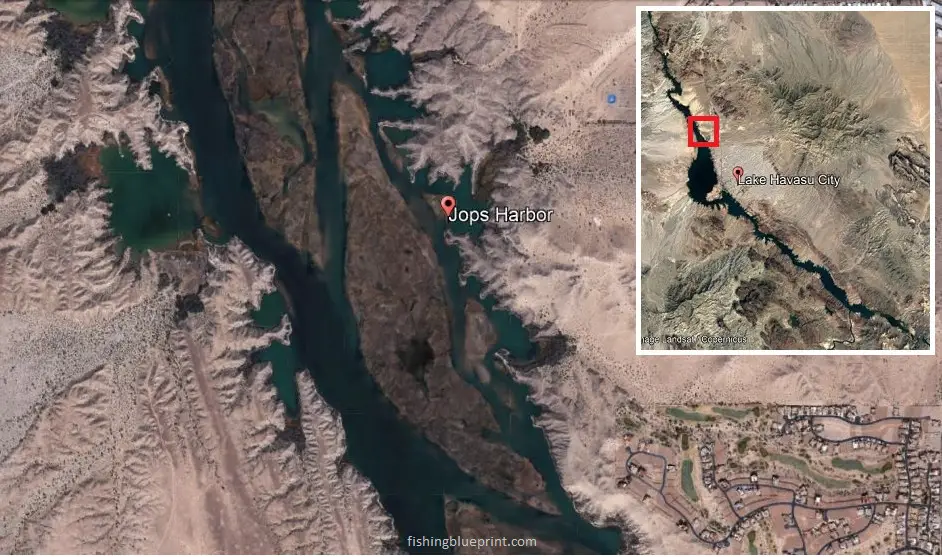
Jops Harbor is another sheltered bay to the north end of the lake.
It’s more open than Catfish Bay, but also has reeds and tulles and a significant amount of submerged vegetation and grass in the summertime.
Jops Harbor is dotted with several narrow points which is great if you like to fish squarebills.
This area is also great for bed fishing in the spring.
This is another great spot if you encounter Havasu’s strong winds or strong currents.
Largemouth can be found in and around the tulles and smallmouth can be caught along with the rocky points and cuts.
Here’s a list of effective baits and techniques you can use in this area:
Calm or post-frontal conditions: Senkos, drop shot rig, tubes, Neko rig, football jigs
Windy, pre-frontal, summer conditions: spinnerbaits, crankbaits, swim jigs, chatterbaits, and underspin jigs.
Artificial habitat/structure: drop shot rig, crankbaits, Neko rig, wacky worm
Grass/ reeds/ tulles: If the grass is submerged you fish over the tops with a topwater lure, buzzbaits, frog lure, chatterbaits, or whopper plopper.
For floating vegetation mats go with a frog lure, flipping lure, heavy vegetation punching bait, or a Texas rigged Senko.
For vertical emergent vegetation such as tall tulles/cattails or patches of thin twig-like reeds, you can use a frog lure, flipping lure, heavy vegetation punching bait. If it’s breezing and you’re fishing emergent vertical vegetation, consider switching to a spinnerbait, swim jig, or chatterbait.
Fish the weedline edges parallel with crankbaits, lipless crankbaits, spinnerbaits, frog lures, soft plastic swimbaits, umbrella rigs, swim jigs, underspin jigs or chatterbaits.
Rocks, points, cuts: crankbaits, jigs, Texas rigs, and Carolina rigs all work really well.
Located: north end of the lake
Structural features: Reeds, tulles, rocky structure (points, cuts, boulders)
Best species to target: Largemouth bass, smallmouth bass, bluegill, tilapia, catfish
Most effective way to fish this spot: Boat, kayak, float tube
Castle Rock Bay
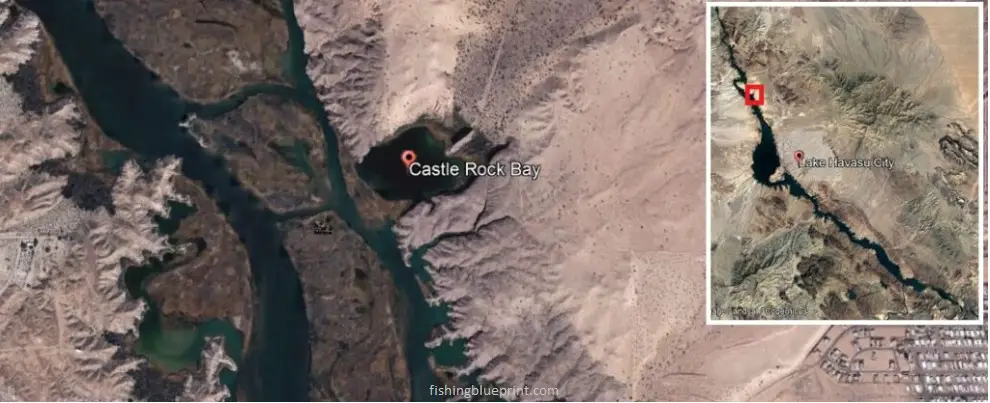
To the north of Jobs Harbor is Castle Rock Bay which is even more tucked away from the two previous coves.
Castle Rock Bay is completely sheltered from the main river channel and is surrounded by reeds and tulles.
Largemouth, bluegill, tilapia, and catfish are commonly caught in this area.
Here’s a list of effective baits and techniques you can use in this area:
Calm or post-frontal conditions: Senkos, drop shot rig, tubes, Neko rig, football jigs
Windy, pre-frontal, summer conditions: spinnerbaits, crankbaits, swim jigs, chatterbaits, and underspin jigs.
Artificial habitat/structure: drop shot rig, crankbaits, Neko rig, wacky worm
Grass/ reeds/ tulles: If the grass is submerged you fish over the tops with a topwater lure, buzzbaits, frog lure, chatterbaits, or whopper plopper.
For floating vegetation mats go with a frog lure, flipping lure, heavy vegetation punching bait, or a Texas rigged Senko.
For vertical emergent vegetation such as tall tulles/cattails or patches of thin twig-like reeds, you can use a frog lure, flipping lure, heavy vegetation punching bait. If it’s breezing and you’re fishing emergent vertical vegetation, consider switching to a spinnerbait, swim jig, or chatterbait.
Fish the weedline edges parallel with crankbaits, lipless crankbaits, spinnerbaits, frog lures, soft plastic swimbaits, umbrella rigs, swim jigs, underspin jigs or chatterbaits.
Rocks, points, cuts: crankbaits, jigs, Texas rigs, and Carolina rigs all work really well.
Located: north end of the lake
Structural features: Reeds, tulles, rocky structure (points, cuts, boulders)
Best species to target: Largemouth, bluegill, tilapia, catfish
Most effective way to fish this spot: Boat, kayak, float tube
Blankenship Bend
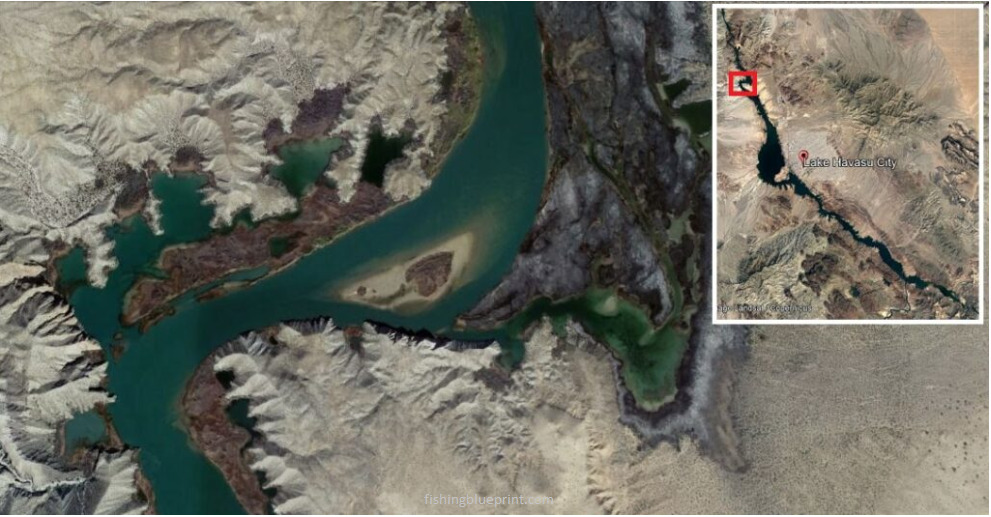
Further upriver a sharp bend to the east marks the location of Blankenship Bend.
Blankenship Bend is more of a collective area of fishing spots, rather than a singular location.
Fishing is best by targeting the inner bend and all the small washout coves the current creates.
Furthermore, anglers can choose to also fish rocky bluff walls just off the main river channel.
Largemouth can be found in and around the tulles and smallmouth can be caught along the rocky points and walls.
Here’s a list of effective baits and techniques you can use in this area:
Calm or post-frontal conditions: Senkos, drop shot rig, tubes, Neko rig, football jigs
Windy, pre-frontal, summer conditions: spinnerbaits, crankbaits, swim jigs, chatterbaits, and underspin jigs.
Artificial habitat/structure: drop shot rig, crankbaits, Neko rig, wacky worm
Grass/ reeds/ tulles: If the grass is submerged you fish over the tops with a topwater lure, buzzbaits, frog lure, chatterbaits, or whopper plopper.
For floating vegetation mats go with a frog lure, flipping lure, heavy vegetation punching bait, or a Texas rigged Senko.
For vertical emergent vegetation such as tall tulles/cattails or patches of thin twig-like reeds, you can use a frog lure, flipping lure, heavy vegetation punching bait. If it’s breezing and you’re fishing emergent vertical vegetation, consider switching to a spinnerbait, swim jig, or chatterbait.
Fish the weedline edges parallel with crankbaits, lipless crankbaits, spinnerbaits, frog lures, soft plastic swimbaits, umbrella rigs, swim jigs, underspin jigs or chatterbaits.
Rocks, points, cuts: crankbaits, jigs, Texas rigs, and Carolina rigs all work really well.
Located: north end of the lake
Structural features: Reeds, tulles, rocky structure (points, cuts, boulders)
Best species to target: Largemouth, bluegill, tilapia, catfish
Most effective way to fish this spot: Boat, kayak
Mid Lake
How to fish artificial structure in Lake Havasu?
Research has definitively shown that the most successful anglers who fish in the mid-lake section of Lake Havasu revolve around fishing around artificial structures.
Yes, I understand there are a handful of fishing docks and some marinas however, if you really want to be successful in this section of the lake, you’ll have to target artificial structures.
What I’m about to share is going to catch me A LOT of flak, and frankly, I probably shouldn’t be sharing this bit of information… but whatever here goes…
As you may know, Lake Havasu is filled with many different types of artificial structures…
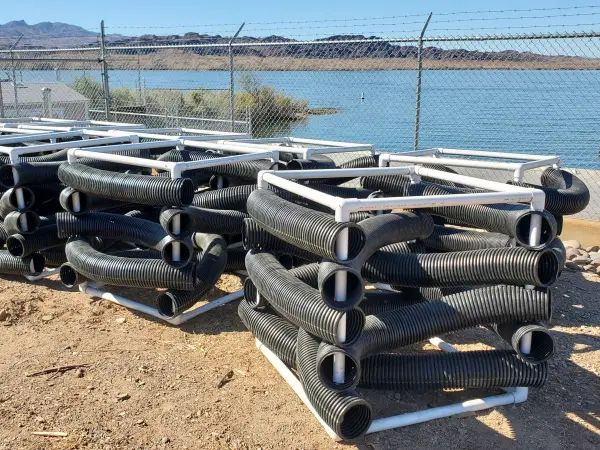
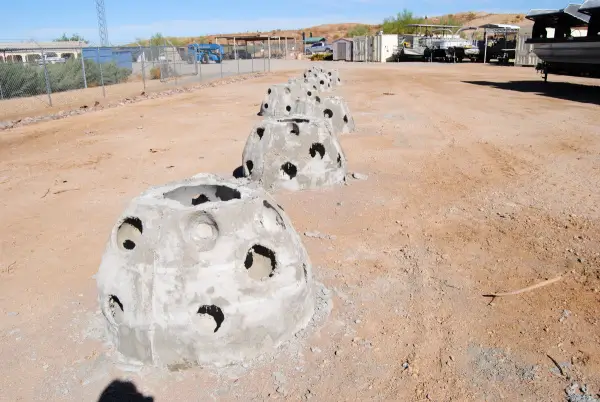
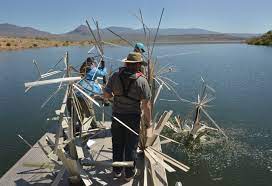
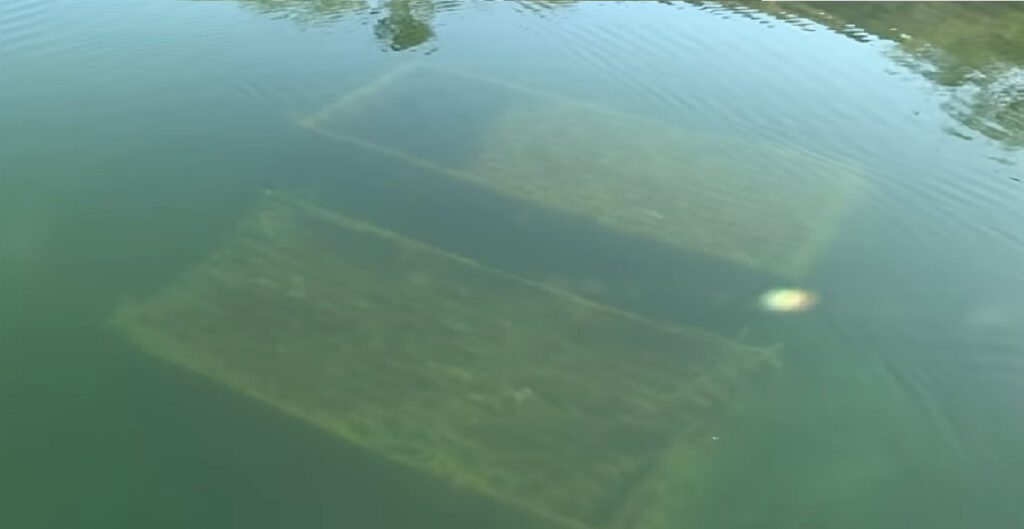
You have not have know, but most of the artificial structures are located in the mid-lake section of the reservoir!
That’s why we made the Lake Havasu Fishing Report!… To help all of you out!
But there is a specific way to fish these structures and that’s what I’m about to share with you…
The best way to fish this area is to do your homework by graphing the various types of structure FIRST.
Sometimes you need to spend HOURS just graphing. Graph and mark every type of structure you find… you’ll need it later.
Second, take note if you see bass or bait on the structure.
Third, pay attention to the other types of secondary cover the bass could be holding in – washes/culverts, submerged grass, drop-offs, ect…
Next, using a finesse bait like a drop shot rig, tubes, Neko rig, mojo rig, crankbait, jerkbait, or wacky Senko, start fishing these various structures keeping note of the following:
- Primary artificial structure
- Nearby secondary structure
- Depth your fishing at
- Technique and bait used
- Other environmental conditions (wind, current strength, water clarity, water temperature, ect…)
After you caught a few fish, start connecting the dots and develop a working plan.
Here’s what an example pattern may look like: Georgia cubes, near a drop off or deeper water, 15-20-feet, caught on a drop shot (calm), tube (calm), and a deep diving jerkbait (reaction).
Remember to evaluate the other structures that meet the criteria you found that you can use as a plan B.
For some reason, bass tend to relate to the same type of structure on any given day.
Windsor Beach Area
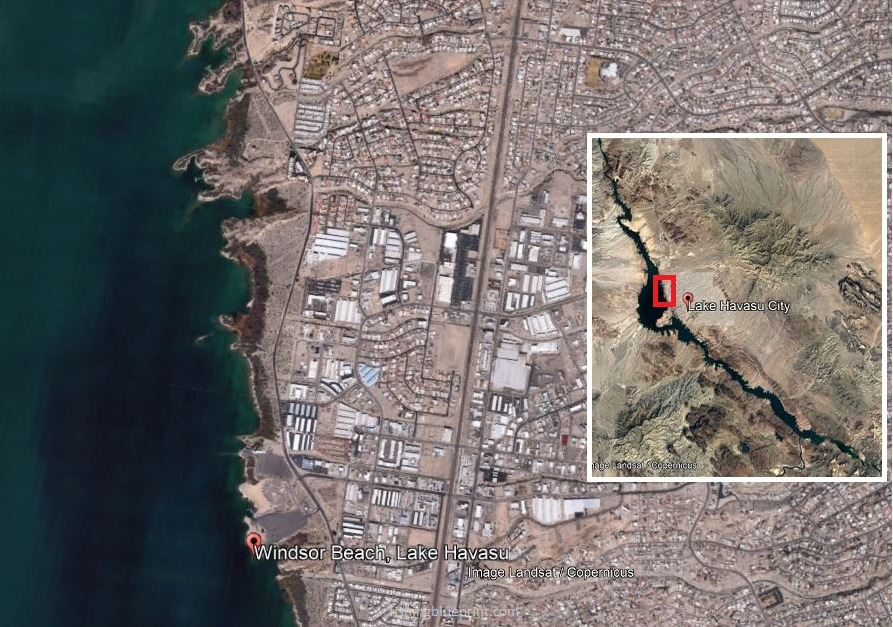
The Windsor Beach area is located on the Arizona side of the lake and it spans nearly a mile and a half of shoreline.
This area has multiple fishing docks, marinas, sightseeing areas, and not surprisingly, this fishing spot is CHALKED full of artificial structures!
Here’s a list of effective baits and techniques you can use in this area:
Calm or post-frontal conditions: Senkos, drop shot rig, tubes, Neko rig, football jigs
Windy, pre-frontal, summer conditions: spinnerbaits, crankbaits, swim jigs, chatterbaits, and underspin jigs.
Artificial habitat/structure: drop shot rig, crankbaits, Neko rig, wacky worm
Grass/ reeds/ tulles: If the grass is submerged you fish over the tops with a topwater lure, buzzbaits, frog lure, chatterbaits, or whopper plopper.
For floating vegetation mats go with a frog lure, flipping lure, heavy vegetation punching bait, or a Texas rigged Senko.
For vertical emergent vegetation such as tall tulles/cattails or patches of thin twig-like reeds, you can use a frog lure, flipping lure, heavy vegetation punching bait. If it’s breezing and you’re fishing emergent vertical vegetation, consider switching to a spinnerbait, swim jig, or chatterbait.
Fish the weedline edges parallel with crankbaits, lipless crankbaits, spinnerbaits, frog lures, soft plastic swimbaits, umbrella rigs, swim jigs, underspin jigs or chatterbaits.
Rocks, points, cuts: crankbaits, jigs, Texas rigs, and Carolina rigs all work really well.
Located: north end of the lake
Structural features: artificial structure, fishing docks, marinas, submerged grass, ledges, drop-offs, culverts, and points
Best species to target: Largemouth bass, smallmouth bass, bluegill, tilapia, catfish
Most effective way to fish this spot: Boat, kayak, float tube
Chalk Cliffs to Ski Cove Three
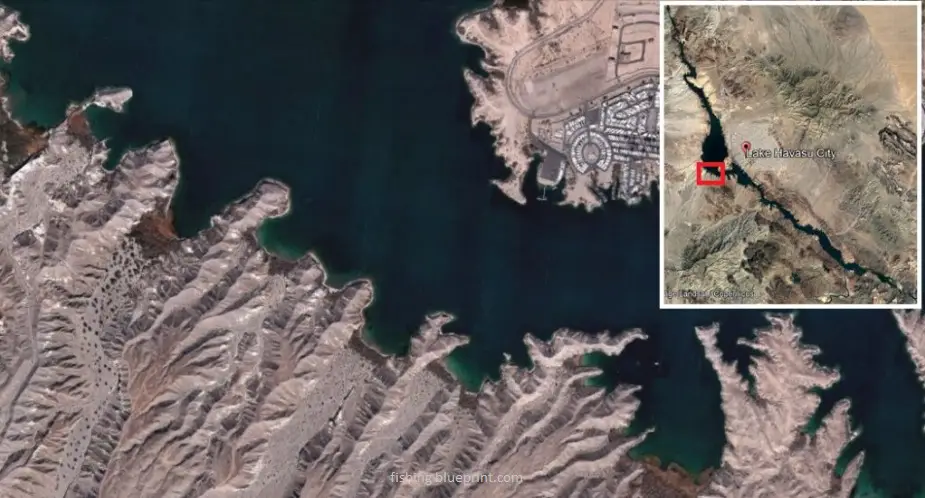
If you’re targeting striped bass, then you have to check out this area.
Schools of striped bass will suspend around the river channel ledge and multiple points this area offers.
The secret to effective striper fishing is using high-quality fish sonar.
Trolling soft plastic swimbaits, hard plastic minnow-style jointed swimbaits, umbrella rigs, silver spoons, white or silver in-line spinners, as well as live bait work the best in the location.
You can also consider using cut frozen anchovies that may be slowly drifting using a drift sock for slowing your boat down without having to drain your battery.
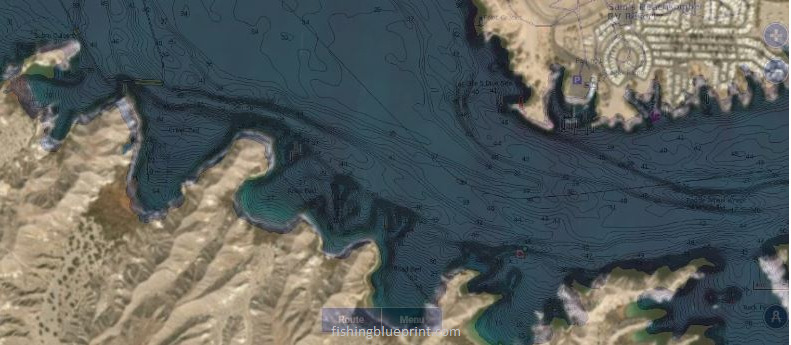
When the stripers are busting on the surface, try walking a topwater bait.
White or silver lipless crankbaits, silver spoons, big in-spinners, and umbrella rigs work really well if it’s windy.
In calm conditions, throw a 4″ soft plastic swimbait like a Little Dipper or Keitech Easy Shiner.
Have a bright-colored crankbait ready if the striped bass dive when the boat approaches the boil; one of these tactics should deliver at least a couple of good fish.
Lastly, do you want to escape the heat? In the evenings, anchor off of points and fish deep with anchovies. Works best when you use a green light to attract the baitfish!
Baits to use: Cast or troll with lipless crankbaits, soft plastic swimbaits, umbrella rigs, swim jigs, underspin jigs, or jointed minnow baits.
Located: mid-lake California side
Structural features: Submerged river channel, ledges, points, sparse artificial structure.
Best species to target: Striped bass, largemouth bass, smallmouth bass, crappie
Most effective way to fish this spot: Boat, kayak, float tube
Ski Cove One to Grass Island
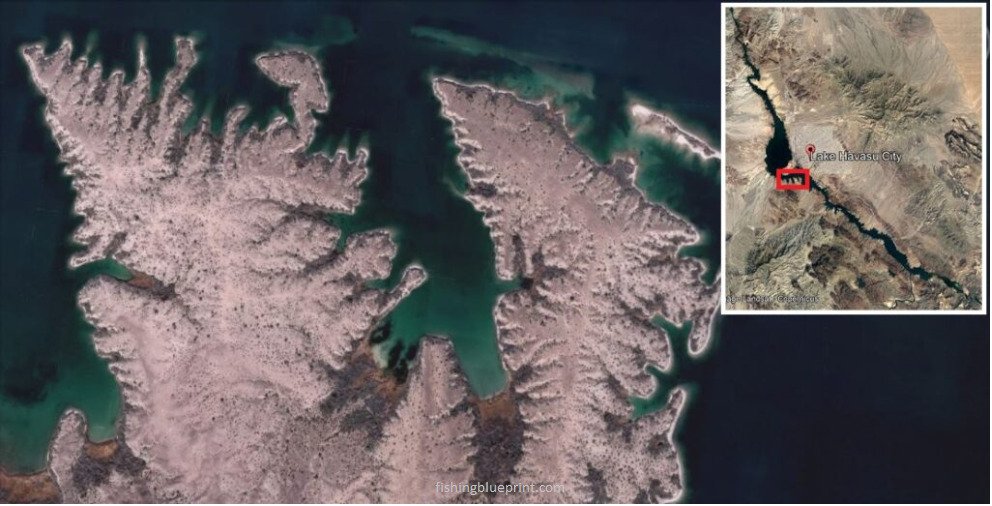
At times the fishing here can be extremely good.
In the summer submerged grass can grow rampant in this section of the lake. There are also patches of submerged brush and timber, along with cuts and runoff channels which can be excellent for largemouth bass.
Here’s a list of effective baits and techniques you can use in this area:
Calm or post-frontal conditions: Senkos, drop shot rig, tubes, Neko rig, football jigs
Windy, pre-frontal, summer conditions: spinnerbaits, crankbaits, swim jigs, chatterbaits, and underspin jigs.
Artificial habitat/structure: drop shot rig, crankbaits, Neko rig, wacky worm
Grass/ reeds/ tulles: If the grass is submerged you fish over the tops with a topwater lure, buzzbaits, frog lure, chatterbaits, or whopper plopper.
For floating vegetation mats go with a frog lure, flipping lure, heavy vegetation punching bait, or a Texas rigged Senko.
For vertical emergent vegetation such as tall tulles/cattails or patches of thin twig-like reeds, you can use a frog lure, flipping lure, heavy vegetation punching bait. If it’s breezing and you’re fishing emergent vertical vegetation, consider switching to a spinnerbait, swim jig, or chatterbait.
Fish the weedline edges parallel with crankbaits, lipless crankbaits, spinnerbaits, frog lures, soft plastic swimbaits, umbrella rigs, swim jigs, underspin jigs or chatterbaits.
Rocks, points, cuts: crankbaits, jigs, Texas rigs, and Carolina rigs all work really well.
Located: southeast end of lake
Structural features: Submerged brush and timber. Large floating tires.
Best species to target: Largemouth bass, smallmouth bass, bluegill, striped bass, crappie
Most effective way to fish this spot: Boat
Daytona Wash to Contact Point
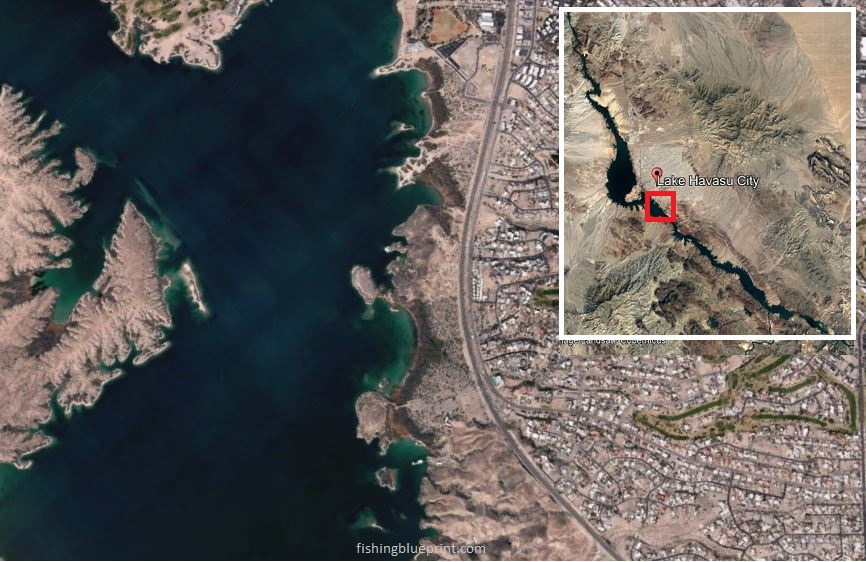
Just south of the London Bridge, this area of the lake is extremely productive and has great access points for many kayak or float tube anglers.
The stretch of lake is loaded with artificial structures, submerged weed flats, cuts, drop-offs, and washes.
In the backs of the pockets and coves, there are large sections of tulles and reeds making it great if you like flipping baits into vegetation or fishing for bluegill.
Due to the river current flowing directly into this area, it’s extremely productive during the early morning and late evenings.
Striped bass will hold over the main lake river channel drop-offs.
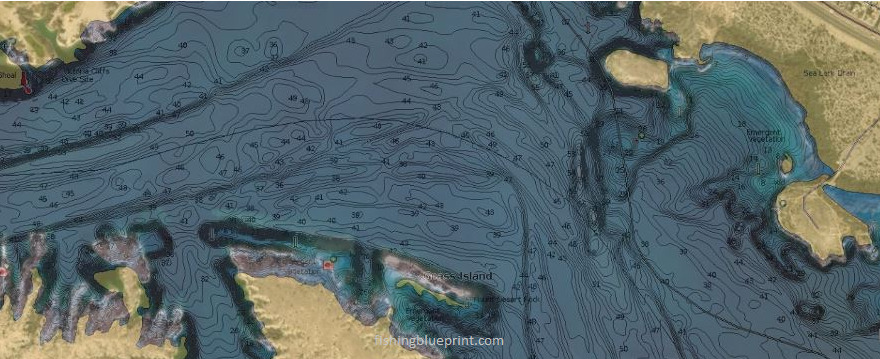
Here’s a list of effective baits and techniques you can use in this area:
Calm or post-frontal conditions: Senkos, drop shot rig, tubes, Neko rig, football jigs
Windy, pre-frontal, summer conditions: spinnerbaits, crankbaits, swim jigs, chatterbaits, and underspin jigs.
Artificial habitat/structure: drop shot rig, crankbaits, Neko rig, wacky worm
Grass/ reeds/ tulles: If the grass is submerged you fish over the tops with a topwater lure, buzzbaits, frog lure, chatterbaits, or whopper plopper.
For floating vegetation mats go with a frog lure, flipping lure, heavy vegetation punching bait, or a Texas rigged Senko.
For vertical emergent vegetation such as tall tulles/cattails or patches of thin twig-like reeds, you can use a frog lure, flipping lure, heavy vegetation punching bait. If it’s breezing and you’re fishing emergent vertical vegetation, consider switching to a spinnerbait, swim jig, or chatterbait.
Fish the weedline edges parallel with crankbaits, lipless crankbaits, spinnerbaits, frog lures, soft plastic swimbaits, umbrella rigs, swim jigs, underspin jigs or chatterbaits.
Rocks, points, cuts: crankbaits, jigs, Texas rigs, and Carolina rigs all work really well.
Located: mid-lake, Arizona side
Structural features: artificial structure, fishing docks, emerging vegetation (tulles and reeds), submerged grass, ledges, drop-offs, culverts, and points
Best species to target: Largemouth bass, striped bass, smallmouth bass, bluegill, catfish
Most effective way to fish this spot: Boat, kayak, float tube, limited shore access
Three Points to Teal Point
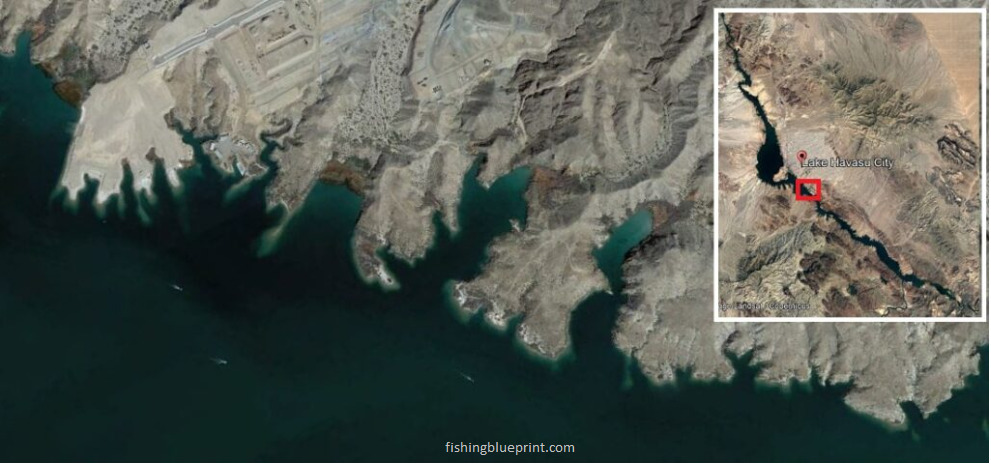
Further down the river sits the section between Three Points and Teal Point.
This area of the lake also has great access points for kayak anglers or float tube fishermen.
Although this stretch of lake is loaded with artificial structures, cuts, drop-offs, pockets, and washes, the area is rockier than the previous, which makes it excellent for smallmouth bass fishing.
In the backs of the pockets and coves, there are sections of tulles and reeds making it great if you like flipping baits into vegetation or fishing for bluegill.
Due to the river current flowing directly into this area, it’s extremely productive during the early morning and late evenings.
Striped bass will hold over the main lake river channel drop-offs.
Some of the effective baits for this area include: flipping creature baits into shadows of the artificial structures, soft plastic swimbaits, topwater lures, buzzbaits, frog lures, chatterbaits, drop shot rig, tubes, Neko rig, football jigs, spinnerbaits, swim jigs, and underspin jigs work great in this area.
But don’t forget about jigs and Texas rigs work great around the rocks, points, and cuts.
Located: mid-lake, Arizona side
Structural features: artificial structure, submerged grass, emerging vegetation (tulles and reeds), ledges, drop-offs, culverts, chunk rock, boulders, and points
Best species to target: Largemouth bass, striped bass, smallmouth bass, bluegill, catfish
Most effective way to fish this spot: Boat, kayak, float tube
Havasu Palms into Whipple Bay

Here’s a great Lake Havasu fishing tip… The area between Havasu Palms and Whipple Bay is a good area to get away from the crowds, that’s why this Lake Havasu fishing report is so helpful!
Most of the crazy recreational boaters do not travel this far down.
RV’ers that are staying in Whipple Point can fish this area from the shore, boat, kayak, or float tube.
This area has a fair amount of artificial structures, docks, marina, drop-offs, pockets, and washes that should be explored.
This area tends to be rockier which makes it great for largemouth bass, smallmouth bass, striped bass, bluegill, and catfish.
Here’s a list of effective baits and techniques you can use in this area:
Calm or post-frontal conditions: Senkos, drop shot rig, tubes, Neko rig, football jigs
Windy, pre-frontal, summer conditions: spinnerbaits, crankbaits, swim jigs, chatterbaits, and underspin jigs.
Artificial habitat/structure: drop shot rig, crankbaits, Neko rig, wacky worm
Grass/ reeds/ tulles: If the grass is submerged you fish over the tops with a topwater lure, buzzbaits, frog lure, chatterbaits, or whopper plopper.
For floating vegetation mats go with a frog lure, flipping lure, heavy vegetation punching bait, or a Texas rigged Senko.
For vertical emergent vegetation such as tall tulles/cattails or patches of thin twig-like reeds you can use a frog lure, flipping lure, heavy vegetation punching bait. If it’s breezing and you’re fishing emergent vertical vegetation, consider switching to a spinnerbait, swim jig, or chatterbait.
Fish the weedline edges parallel with crankbaits, lipless crankbaits, spinnerbaits, frog lures, soft plastic swimbaits, umbrella rigs, swim jigs, underspin jigs, or chatterbaits.
Rocks, points, cuts: crankbaits, jigs, Texas rigs, and Carolina rigs all work really well.
Located: lower-lake, California side
Structural features: artificial structure, submerged grass, emerging vegetation (tulles and reeds), ledges, drop-offs, culverts, chunk rock, boulders, and points
Best species to target: Largemouth bass, striped bass, smallmouth bass, bluegill, catfish
Most effective way to fish this spot: Boat, kayak, float tube, limited shore access
Lower Lake
Three Dunes Point to Cattail Cove State Park
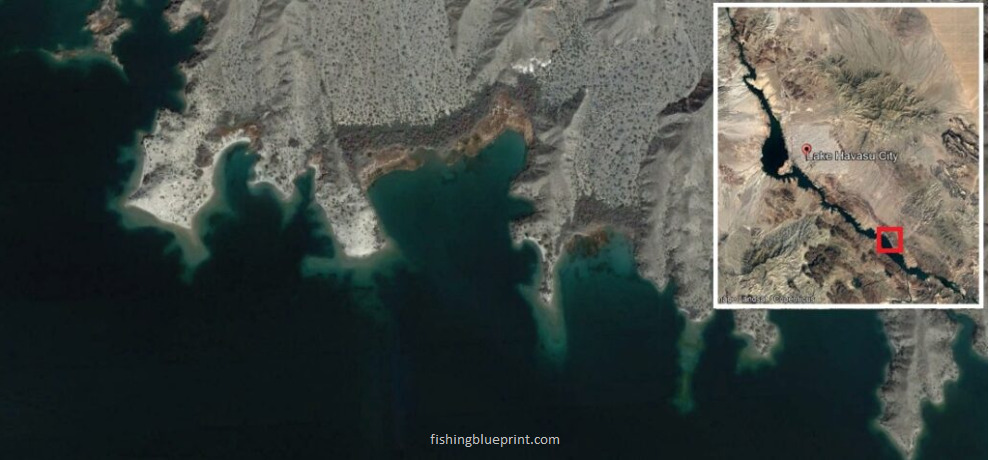
The area between Three Dunes Point and Sandpoint Marina is great for seclusion.
Most of the crazy recreational boaters do not travel this far down.
Campers and RV’ers that are staying in Sandpoint can fish this area from the shore, boat, kayak, or float tube.
This area is also loaded with artificial structures, cuts, drop-offs, pockets, and washes.
This area tends to be rockier which makes it great for largemouth bass, smallmouth bass, striped bass, bluegill, and catfish.
Here’s a list of effective baits and techniques you can use in this area:
Calm or post-frontal conditions: Senkos, drop shot rig, tubes, Neko rig, football jigs
Windy, pre-frontal, summer conditions: spinnerbaits, crankbaits, swim jigs, chatterbaits, and underspin jigs.
Artificial habitat/structure: drop shot rig, crankbaits, Neko rig, wacky worm
Grass/ reeds/ tulles: If the grass is submerged you fish over the tops with a topwater lure, buzzbaits, frog lure, chatterbaits, or whopper plopper.
For floating vegetation mats go with a frog lure, flipping lure, heavy vegetation punching bait, or a Texas rigged Senko.
For vertical emergent vegetation such as tall tulles/cattails or patches of thin twig-like reeds you can use a frog lure, flipping lure, heavy vegetation punching bait. If it’s breezing and you’re fishing emergent vertical vegetation, consider switching to a spinnerbait, swim jig, or chatterbait.
Fish the weedline edges parallel with crankbaits, lipless crankbaits, spinnerbaits, frog lures, soft plastic swimbaits, umbrella rigs, swim jigs, underspin jigs, or chatterbaits.
Rocks, points, cuts: crankbaits, jigs, Texas rigs, and Carolina rigs all work really well.
Located: lower-lake, Arizona side
Structural features: artificial structure, submerged grass, emerging vegetation (tulles and reeds), ledges, drop-offs, culverts, chunk rock, boulders, and points
Best species to target: Largemouth bass, striped bass, smallmouth bass, bluegill, catfish
Most effective way to fish this spot: Boat, kayak, float tube, limited shore access
Bass Isles to Powerline Cove
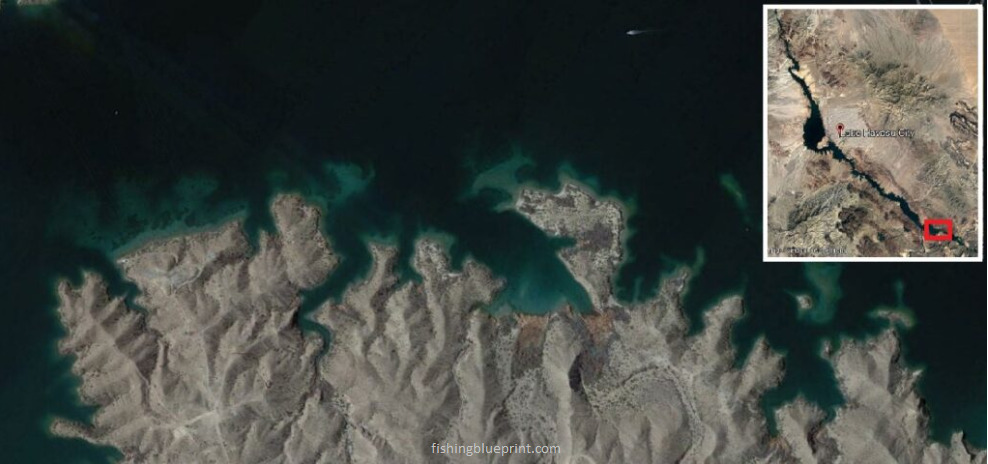
This area can definitely be overwhelming for someone who has never been here before, frankly because there are so many options and structures to fish.
Luckily due to its location, it’s not really frequented very often. And if you do see another angler, the area is so big you can easily find another spot!
Lake Havasu fishing fishing areas like this are also loaded with artificial structures, cuts, drop-offs, pockets, and washes.
In my opinion, the most unique feature in the area is the presence of underwater shelves and submerged humps that range between 9-25 feet of water.
This area tends to be rockier which makes it great for largemouth bass, smallmouth bass, striped bass, bluegill, and catfish.
Here’s a list of effective baits and techniques you can use in this area:
Calm or post-frontal conditions: Senkos, drop shot rig, tubes, Neko rig, football jigs
Windy, pre-frontal, summer conditions: spinnerbaits, crankbaits, swim jigs, chatterbaits, and underspin jigs.
Artificial habitat/structure: drop shot rig, crankbaits, Neko rig, wacky worm
Grass/ reeds/ tulles: If the grass is submerged you fish over the tops with a topwater lure, buzzbaits, frog lure, chatterbaits, or whopper plopper.
For floating vegetation mats go with a frog lure, flipping lure, heavy vegetation punching bait, or a Texas rigged Senko.
For vertical emergent vegetation such as tall tulles/cattails or patches of thin twig-like reeds you can use a frog lure, flipping lure, heavy vegetation punching bait. If it’s breezing and you’re fishing emergent vertical vegetation, consider switching to a spinnerbait, swim jig, or chatterbait.
Fish the weedline edges parallel with crankbaits, lipless crankbaits, spinnerbaits, frog lures, soft plastic swimbaits, umbrella rigs, swim jigs, underspin jigs, or chatterbaits.
Rocks, points, cuts: crankbaits, jigs, Texas rigs, and Carolina rigs all work really well.
Located: lower-lake, Arizona side.
Structural features: artificial structure, submerged grass, emerging vegetation (tulles and reeds), ledges, drop-offs, culverts, chunk rock, boulders, and points
Best species to target: Largemouth bass, striped bass, smallmouth bass, bluegill, catfish
Most effective way to fish this spot: Boat, kayak, float tube, limited shore access
Bill Williams River
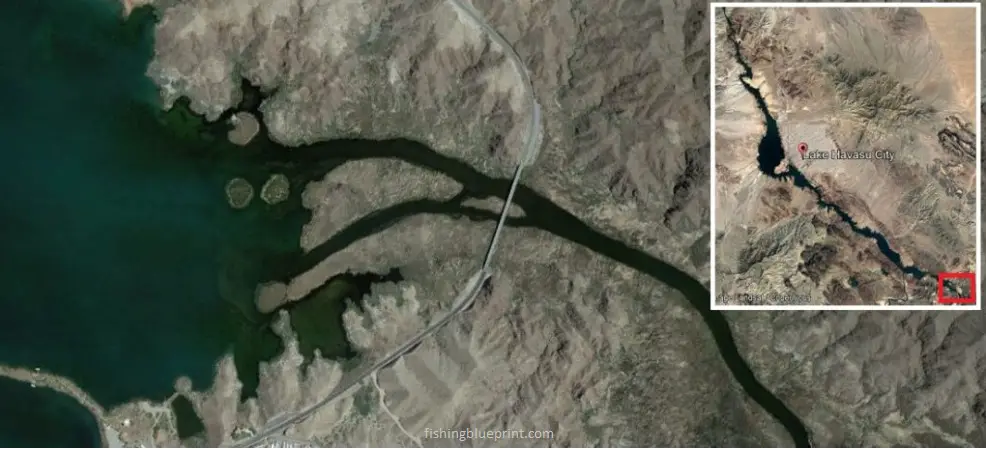
Located about 25miles south of Lake Havasu City, the Bill Williams River drains into Lake Havasu
The mouth is a relatively open area that can be fished for both largemouth and striped bass.
The river is lined with tall reeds and tulles.
This is a great spot if you want quiet solitude or want to avoid Havasu’s strong winds or strong currents.

Anglers have the option to fish the mouth of the Bill Williams River or up the tulle-lined canals.
Striper fishermen tend to have had the best success by casting or trolling lipless crankbaits, soft plastic swimbaits, umbrella rigs, swim jigs, underspin jigs, or jointed minnow baits.
In the evenings, anchor off of points and fish deep with anchovies. Works best when you use a green light to attract the baitfish!
Baits to use:
If the grass is submerged you fish over the tops with a topwater lure, buzzbaits, frog lure, chatterbaits, or whopper plopper.
For floating vegetation mats go with a frog lure, flipping lure, heavy vegetation punching bait, or a Texas rigged Senko.
For vertical emergent vegetation such as tall tulles/cattails or patches of thin twig-like reeds you can use a frog lure, flipping lure, heavy vegetation punching bait. If it’s breezing and you’re fishing emergent vertical vegetation, consider switching to a spinnerbait, swim jig, or chatterbait.
Fish the weedline edges parallel with crankbaits, lipless crankbaits, spinnerbaits, frog lures, soft plastic swimbaits, umbrella rigs, swim jigs, underspin jigs or chatterbaits.
Believe it or not your best chance of success is to target this area in the hottest part of the day. Bass will tuck themselves deep in shadows thereby pinning themselves deep in the shadows.
Be sure to use a heavy fishing line when fishing thick vegetation.
Located: south end of lake
Structural features: Reeds, tulles, open bay
Best species to target: Largemouth bass, striped bass, tilapia, bluegill
Most effective way to fish this spot: Boat
More Lake Havasu Fishing Tips..
Bass Popultion In Lake Havasu
You may be wondering… How do you fish for bass in Lake Havasu? The population of these popular species has grown tremendously in both size and number, thanks to a massive habitat rehabilitation initiative that began in the 1990s.
It is not unusual for new fishermen to have a great day at this lake, while expert anglers regularly report winning tournaments with a standard five fish limit and bags weighing over 20+ pounds.
Aside from the manmade habitat, Lake Havasu offers a variety of other habitat alternatives for fishermen.
Marshes with shallow and submerged weeds, reeds and tules, boat docks, marinas, bluff walls, ledges, river channels, and rocky shorelines all have the potential to host bass, but each requires a somewhat different technique to catch them.
Largemouth Bass Fishing at Lake Havasu
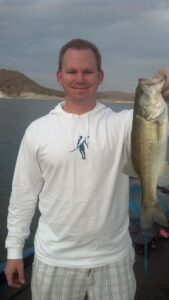 Spawn: Spring, March-May
Spawn: Spring, March-May
Food: Shad, bluegill, crayfish
Arizona State Record: 16 lb. 7.68 oz. 28.0 in., Canyon Lake Randall E. White, Mesa 4/22/97
Table Quality: Decent. Firm white meat.
Angling techniques:
Smallmouth Bass Fishing at Lake Havasu
 Spawn: March-May
Spawn: March-May
Food: fish, crustaceans.
Arizona State Record: 6 lb. 4.48 oz. 21 in. Lake Havasu Sue Nowak, 2/23/17
Table Quality: Similar to a largemouth bass it’s firm, white, flaky, mild-tasting
Angling techniques:
- Finesse jigs
- Mojo Rig
- Neko Rig
- Small crankbaits
- Football Jigs
- Soft plastic swimbaits
- Jerkbaits
- Chatterbaits
- Swim jigs
- Hair jigs
- Underspin jigs
- Drop shot plastic worms
- Tubes
- Streamer flies.
- Live baits: minnows, hellgrammites, and crayfish
Striped Bass Fishing at Lake Havasu
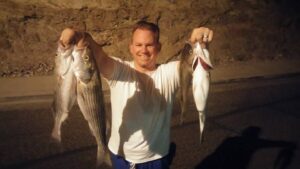 In the late 1960s, striped bass were introduced into Lake Mead, Lake Powell, and Lake Havasu. Unlike Mead, however, Lake Powell and Havasu have enjoyed a thriving striper population ever since.
In the late 1960s, striped bass were introduced into Lake Mead, Lake Powell, and Lake Havasu. Unlike Mead, however, Lake Powell and Havasu have enjoyed a thriving striper population ever since.
Striped bass are considered true bass, unlike largemouth and smallmouth which are a part of the sunfish family.
How do you catch striped bass in Lake Havasu?
Striped bass are pelagic feeders (like white bass and yellow bass) and are constantly on the move. They hunt and feed in schools. The average size of striped bass in Lake Havasu is around 1-3 pounds.
General Striped Bass Details
Spawn: April – mid-June in flowing water, current or rivers
Food: Shad, dead or alive.
Arizona State Record: 29 lb. 13.76 oz. 45.25 in., Lake Pleasant. Bob Liddington, Phoenix 7/13/10
Table Quality: The meat is excellent. It’s firm, flaky and white. There is a red lateral line that must be removed otherwise it gives off a strong “fishy” taste. Otherwise, these make excellent fish fry meals.
Angling techniques:
- Frozen shad or anchovies as “cut bait”
- Small soft plastic swimbait
- Spoons
- Jointed crankbaits
- Swim jigs
- Streamer flies
Crappie Fishing at Lake Havasu
Spawn: April – mid-June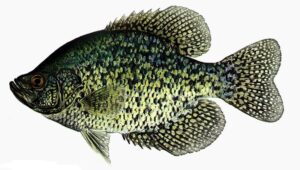
Food: Larvae, small fish, and crustaceans. Threadfin shad make up their main diet.
Arizona State Record: 4 lb. 10.0 oz. –in., San Carlos Lake John Shadrick, Mammoth 1959
Table Quality: The meat is excellent. It’s firm, flaky and white.
Angling techniques:
- Live minnows under bobbers
- Crappie jigs
- Crappie tubes
- Spoons
- Spinners
Catfish Fishing at Lake Havasu
There are two species of catfish in Lake Havasu. The channel catfish and flathead catfish. The flathead species was purposely introduced when the lake was first created.
In 2018, George Terro of Bullhead City caught a gigantic channel catfish well over 20+ pounds which challenged the Colorado River record holder.
Channel catfish weight will range from 0.5-to-10-pounds in Lake Havasu, however the average weight will be between 1-4-pounds. Conversely, “smaller” flathead catfish will weigh in at 15-pounds and can grow around 75-pounds. A flathead survey conducted in 2016 and 2020 caught a flathead that weighed over 48-pounds!
General Catfish Details
Spawn: March-June
Food: Carp, bluegill
Arizona State Record:
Channel catfish – 33 lb., 5.76 oz., 39.5 in., Upper Lake Mary Carson Pete, 3/26/17
Flathead catfish – 76 lb. 8.64 oz., 53.5 in., Bartlett Lake Eddie Wilcoxson, Surprise 04/13/13
Table Quality: Soft white meat. In the summer the meat will taste muddy.
Angling techniques:
Flathead catfish:
- live bait such as smaller carp, full sized bluegill, or tilapia
Channel catfish:
- chicken liver
- hotdogs
- stink bait
- small bluegill
- small carp
Bluegill Fishing at Lake Havasu
Spawn: April and May
Food: Small fish and insects
Arizona State Record: 3 lb. 15.68 oz. 15.75 in., Goldwater Lake. Christopher Ray Mapes, Prescott Valley 5/2/04
Table Quality: Firm, white meat
Angling techniques:
- Worms
- Dough balls
- Slim jim sausages pieces on a small hook (not lying… it really works)
- Small spinners
- Trout flys
Carp Fishing at Lake Havasu
Spawn: March-June
Food: algae, plant matter, fish eggs, insects, aquatic worms, small crustaceans (snails), and small crayfish
Arizona State Record: 37 lb. 0.0 oz. 40.0 in., Bartlett Lake Jonathan Gardner, Phoenix 8/8/87
Table Quality: Poor. Soft white flesh that is muddy and riddled with bones
Angling techniques:
- Dough balls
- Corn
- Worms
- Cherry tomatoes (not kidding)
- Commercial carp baits
Marinas/ Boat Ramps at Lake Havasu
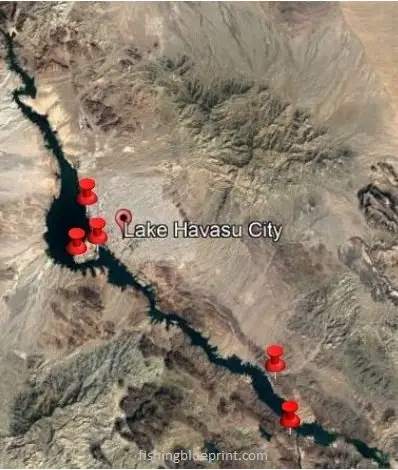
Windsor Beach
Location: Mid-lake Arizona side
Address: 699 London Bridge Rd, Lake Havasu City, AZ 86403
Phone number: (623) 235-6130
Number of lanes: 12
Bathrooms: Yes
Showers: No
Electric: Yes
Camping nearby: No
Lake Havasu Marina
Location: Mid-lake Arizona side
Address: 1100 McCulloch Blvd N, Lake Havasu City, AZ 86403
Phone number: +1-928-855-2159
Number of lanes: 7
Bathrooms: Yes
Showers: No
Electric: Yes
Camping nearby: Yes
Site Six
Location: Mid-lake Arizona side
Address: Beachcomber Blvd, Lake Havasu City, AZ 86403
Phone number: +1-928-453-8686
Number of lanes: 3
Bathrooms: Yes
Showers: No
Electric: Yes
Camping nearby: Yes
Cattail Cove
Location: Lower lake Arizona side
Address: AZ-95, Lake Havasu City, AZ 86406
Phone number: +1-928-855-1223
Number of lanes: 3
Bathrooms: Yes
Showers: Yes
Electric: Yes
Camping nearby: Yes
Parker Dam Launch
Location: South-end of the lake
Address: Takeoff Point Rd, Parker, AZ 85344
Phone number: none
Number of lanes: 1
Bathrooms: yes
Showers: No
Electric: No
Camping nearby: Yes
Tackle Shops & Tackle Retailers In Lake Havasu
Bass Tackle Master
Have a store located in Lake Havasu City and is just north of the London Bridge on London Bridge road. Bass Tackle Master is your no frills, to the point tackle shop. The staff is friendly, patient, and knowledgeable. Bass Tackle Master carries a wide variety of gear for every striped bass, largemouth, smallmouth, catfish, and crappie angler.
- Address - 260 London Bridge Rd, Lake Havasu City, AZ 86403
- Phone number - (928) 854-2277
- Website - Bass Tackle Master
- Payment methods accepted - Cash, credit, debit, apple pay
West Marine
Also located in Lake Havasu City and across from Windsor Breach. West Marine has a small selection of tackle but more importantly is your go to resource in the event you have any boating trouble on the lake. The staff is courteous, approachable, and knowledgeable.
- Address - 1517 Industrial Blvd, Lake Havasu City, AZ 86403
- Phone number - (928) 505-4444
- Website - West Marine
- Payment methods accepted - Cash, credit, debit, apple pay
Tackle Shops & Tackle Retailers In Phoenix (before you go)
Sportsman's Warehouse
Have a store located at the north end of Phoenix, Sportsman’s Warehouse feels like a combination of a small outdoor outfitter shop with the capacity to hold a large amount of tackle, gear, and other outdoor accessories. The staff is friendly, patient, and knowledgeable. Sportsman’s Warehouse carries a wide variety of gear for every bass, catfish, trout, crappie, walleye, and pike to get you started.
- Address - 19205 N 27th Ave, Phoenix, AZ 85027
- Phone number - (623) 516-1400
- Website - Sportsman’s Warehouse
- Payment methods accepted - Cash, credit, debit, apple pay
The Hook-Up Tackle
Located in Northwest Phoenix, The Hook Up Tackle offers a massive amount of gear, tackle, and accessories for any budget. Opening in 2008, The Hook Up Tackle has everything you need especially if you’re into bass fishing. They even offer hard to find bait and products from Japan.
- Address - 8990 W Windsor Dr #101, Peoria, AZ 85381
- Phone number - (623) 412-3474
- Website - The Hook Up Tackle
- Payment methods accepted - Cash, credit, debit
Phoenix Fishing Supply
Located in central Phoenix, Phoenix Fishing Supply has been around since the 1980’s! Even before the big-box stores came into town Phoenix Fishing Supply has been catering to all types of anglers and offers a huge selection of products.
- Address - 4810 North 16th Street, Phoenix, Arizona 85016
- Phone number - (602) 266-2624
- Website - Phoenix Fishing Supply
- Payment methods accepted - Cash, credit, debit
Liar's Korner
Liar’s Korner Fishing Bait & Tackle is nestled in the far east side of metro Phoenix. This tackle shop is proudly run as a small family business that is serious about giving you the right gear to help you catch fish. It doesn’t matter if you’re fishing bass, crappie, walleye, or trout. They have what you need. They carry all the name brands of tackle and gear, and frequently offer better prices than the big-box companies.
- Address - 9529 E Main St, Mesa, AZ 85207
- Phone number - (480) 986-2515
- Website - Liar's Korner facebook page
- Payment methods accepted - Cash, credit, debit
Bass Pro Shops
Located on the east side Phoenix, Bass Pro Shops caters to very type of angler who wants to get their line wet. Founded in 1972 by angler Johnny Morris in Springfield, Missouri Bass Pro Shops combines a massive tackle shop with their hunting, boating, conservation, and guide trips into a comprehensive outdoor and fishing retailer.
- Address - 1133 N Dobson Rd, Mesa, AZ 85201
- Phone number - (602) 606-5600
- Website - Bass Pro Shops
- Payment methods accepted - Cash, credit, debit
Other Recreational Activities to Know About Lake Havasu
For more information on annual events please click here.
London Bridge Recreational Complex – Live music and other social events at multiple restaurants as well as seasonal festivals.
The City Of Lake Havasu also offers:
- Arts & craft shows
- Farmers markets
- Annual National Public Lands Day Canoe & Kayak Clean-Up
- Poker Runs
- Ghost Tours
- Meteorite Hunts
- Rock Hounding Tours
- Annual powerboat races
- and much, much more…
Casinos & Gaming
After a hard day of fishing relax and unwind while having a frosty beverage and doing a little gambling. Lake Havasu is home to multiple locations to test your luck!
Hotels Near This Lake
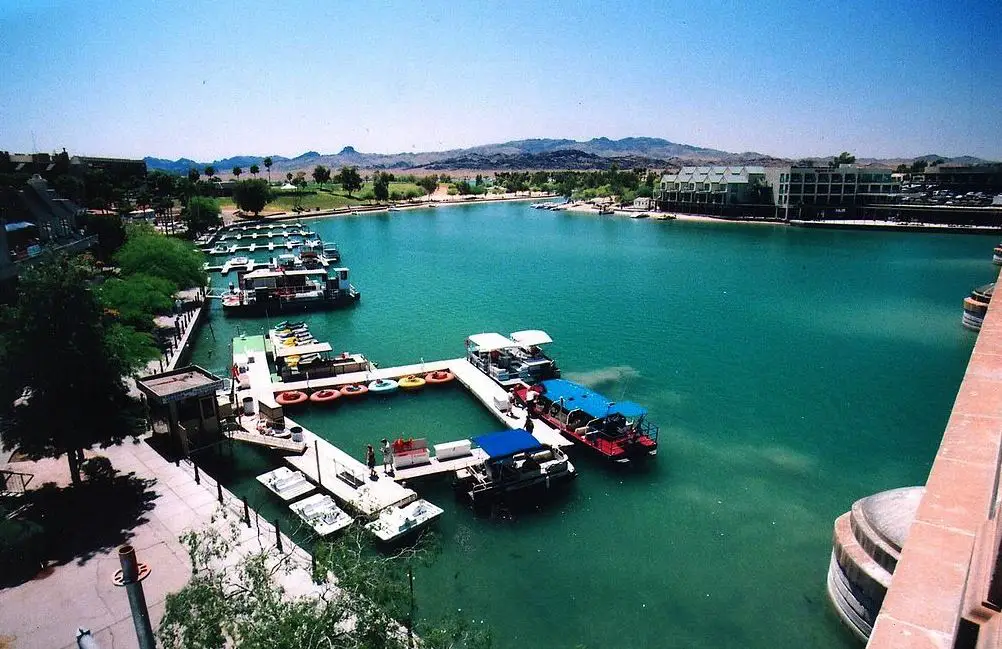
Don’t want to camp and need a place to stay when you’re visiting this lake? Rest assured you’re covered!
Finding a quality place to stay can take a long time which is why we’re providing you with a list of quality travel options when you stay at this lake.
Check out this list of hotels and resorts you should consider staying at:
WorldMark Havasu Dunes
620 Lake Havasu Ave S, Lake Havasu City, 86406, AZ
1.4 miles to London Bridge/Lake Havasu State Park
Motel 6 Lake Havasu, AZ – Lakeside
111 London Bridge Rd, Lake Havasu City, 86403, AZ
0.3 miles to London Bridge/Lake Havasu State Park
The Nautical Beachfront Resort
1000 Mcculloch Blvd N, Lake Havasu City, 86403, AZ
0.6 miles to London Bridge/Lake Havasu State Park
Island Suites
236 Lake Havasu Ave S, Lake Havasu City, 86403, AZ
0.4 miles to London Bridge/Lake Havasu State Park
Heat Hotel, Lake Havasu City
1420 N McCulloch Blvd, Lake Havasu City, 86403, AZ
0.1 miles to London Bridge/Lake Havasu State Park
Quality Inn & Suites Lake Havasu City
271 Lake Havasu Ave S, Lake Havasu City, 86403, AZ
0.5 miles to London Bridge/Lake Havasu State Park
Havasu Landing Resort & Casino
13145 Havasu Lake Road, Needles, 92363, CA
11 miles to Lake Havasu City
3.3 miles to London Bridge
In Summary...
As you now can see Lake Havasu fishing can be tough at times, but it’s not impossible and with the help of the Lake Havasu Fishing Report… It definitely helps you get started on the right foot quickly and easily, so you can avoid wasting hours wondering where and how to get started.
But Let Me Ask You a Question…
Do you now have a better sense of where you can get started, even if you have have been here? YES, we went over all the best locations to start when you get to this lake!
Do you feel that you have a good grasp of what species are in this lake? YES, we went over using multiple helpful lists so you don’t waste your time and money going after the wrong species of fish!
Do you have a good understanding what baits are needed to catch each of the different species of fish? YES, we hammered this topic several times in the fishing report what baits and lures are needed to each and every fish!
That’s right!… If you made it this far you know I truly over delivered for you… I gave away secrets about this lake that I haven’t told anyone until publishing this report.
I Need To Ask A Favor From You And It’s Not Going To Cost You A Single Dime…
If you have gotten anything out of this free report; whether its knowing where to get started, what kinds of fish are in Lake Pleasant, what baits to use, where to launch your boat, where to buy a frosty beverage, where to camp, and other things to do when you’re at this lake…
Then I need you to do something that is going to help you your fellow angler…
And that is share this report. Please share it to as many people as you can. It’s free to you and it really helps me out as a creator.
THIS IS WHERE YOU CAN HELP ME THE MOST: There’s a lot of information about this subject you have found helpful, and I’m sure you’ll be able to put some of the knowledge bombs to use. But sharing this report helps drive traffic which in turn helps me at absolutely no cost to you. I love creating reports like this for you, and you like reading these types of reports please share this with your friends, family, and fellow anglers.
Click on your favorite social media buttons to share this page now!
Other Arizona Related Fishing Articles
- Top 20 Best Places To Fish In Arizona 2023
- Interactive AZ Fishing Map 2023 – Where To Go Fishing In Arizona
- How much does a Arizona fishing license cost?
- Best Tackle Shops In Phoenix Arizona 2023
- Best Bass Fishing Lakes in Arizona 2023 (Voted by Local Anglers!)
- Alamo Lake Fishing Report 2025
- Apache Lake Fishing Report 2025
- Ashurst Lake Fishing Report 2025
- Bartlett Lake Fishing Report 2025
- Bear Canyon Lake Fishing Report 2025
- Big Lake Fishing Report 2025
- Blue Ridge Reservoir Fishing Report 2025
- Canyon Lake Fishing Report 2025
- Chevelon Lake Fishing Report 2025
- Kinnikinick Lake Fishing Report 2025
- Lake Havasu Fishing Report 2025
- Lake Mary Fishing Report 2025
- Lake Pleasant Fishing Report 2025
- Patagonia Lake Fishing Report 2025
- Rainbow Lake Fishing Report 2025
- Roosevelt Lake Fishing Report 2025
- Saguaro Lake Fishing Report 2025
- Show Low Lake Fishing Report 2025
- Sunrise Lake Fishing Report 2025
- Willow Springs Lake Fishing Report 2025
- Woods Canyon Lake Fishing Report 2025
Other California Related Fishing Articles
- Bass Lake Fishing Report
- Clear Lake Fishing Report
- Castaic Lake Fishing Report
- California Delta Fishing Report
- Diamond Valley Lake Fishing Report
- Don Pedro Reservoir Fishing Report
- Eagle Lake Fishing Report
- El Capitan Reservoir Fishing Report
- Lake Berryessa Fishing Report
- Big Bear Lake Fishing Report
- Folsom Lake Fishing Report
- Irvine Lake Fishing Report
- Lake Almanor Fishing Report
- Lake Camanche Fishing Report
- Lake Isabella Fishing Report
- Lake Havasu Fishing Report
- Lake McClure Fishing Report
- Lake Oroville Fishing Report
- Lake Perris Fishing Report
- Lake Piru Fishing Report
- Lake Skinner Fishing Report
- Lake Tahoe Fishing Report
- Los Banos Reservoir Fishing Report
- New Hogan Lake Fishing Report
- New Melones Lake Fishing Report
- O’Neill Forebay Fishing Report
- Pardee Lake Fishing Report
- Pyramid Lake Fishing Report
- San Luis Reservoir Fishing Report
- San Vicente Reservoir Fishing Report
- Shasta Lake Fishing Report
- Silverwood Lake Fishing Report
- Trinity Lake Fishing Report
- Whiskeytown Lake Fishing Report
George Servinson
My name is George and I'm been fishing my entire life and love all things outdoors. My passion is helping anyone catch more fish. The newest things I've been doing lately is learning how to break down and clean all my reels, teaching my boy how to kayak fish, and bushcraft wilderness survival.

